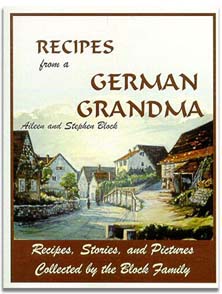RYE SOUR: (starter)
Prepare 48 hours in advance
1/2 cup rye flour
1/8 teaspoon active dry yeast
1 cup warm water
1 tablespoon crushed caraway seeds (optional)
1 teaspoon minced onion
Combine all the ingredients in a large bowl and mix until smooth. The mixture should have a thin consistency. Cover and allow to stand in a warm spot until bubbly and fermented. It can be left up to 24 hours.
|
Prepare 24 hours in advance of making your bread.
Stage 1
1/2 cup water
1 1/4 cups rye flour
All of the Starter above
1/4 cup rye flour for sprinkling
In a large bowl combine the water, 1 1/4 cups of the flour, and the starter; stir until smooth. The dough should pull slightly and may start to come away from the sides of the bowl. Wipe down the sides of the bowl with wet hands or a bowl scraper. Sprinkle 1/4 cup of flour over the entire surface of the sour. Let stand, covered with a cloth or plastic wrap until doubled in size and the floured top appears cracked with fissures spread widely apart. This may take 4 to 8 hours. Avoid letting the sour collapse.
|
STAGE 2
1/2 cup warm water
1 cup rye flour
All of above sour
Add the water and 3/4 cup of the flour, mix until smooth. Sprinkle 1/4 cup flour over the entire surface of the sour. Allow to rise in a warm place for 4 to 8 hours. |
STAGE 3
1/2 cup water
1 cup rye flour or more
All of above sour
Add the water and the 1 cup of flour; mix until smooth. Add additional flour as needed to attain a dough-like consistency.
The sour, when fully risen in stage three (about 8 hours) is ready for use in the dough. |
PUMPERNICKEL COLOUR: 6 tablespoons sugar
2 tablespoons water
pinch of cream of tartar
1/2 cup boiling water
In a heavy sauce pan over low heat, melt the sugar with the 2 tablespoons water.
Using extreme care, add the boiling water. Stir to dissolve, then let cool to room temperature.
Increase heat to medium high, cover the pan, bring to a boil, and boil for 2 minutes. Add the cream of tartar and continue to boil, uncovered, until the sugar is almost black in color. Remove the pan from the heat. The sugar will continue to cook and darken. Allow it to cool.
|
Cooking the Rye Berries
To 3 cups boiling water add 1 cup chopped rye berries. Bring the water to a second boil, then cook, covered, over low heat until the cereal is tender (about
45 minutes). |
Making the Dough In a large bowl sprinkle the yeast over the warm water; stir to dissolve. Add the Rye sour, cooked rye berries, pumpernickel color, pumpernickel flour and salt. Stir until dough comes away from sides of the bowl, adding rye flour 1/4 cup at a time if necessary. This dough will remain wet, with the consistency of heavy clay. Turn out onto a lightly oiled work top.


Divide the dough into 8 balls
|

Take each piece and form it into a ball.
Draw the ball toward you with hands placed this way.
This will help seal the bottom and make a nice smooth looking ball.
|

Let each ball rise until double.
If it is drafty you can do this in a lightly warmed oven.
|
|

Punch down the dough |

|

Place on pans and let rise again.
This is a large pan, because we had a large oven.
For a home size oven only 2 loaves will fit on a pan.
Cut 3 lines in the top with a razor blade or very sharp thin knife for the steam to escape. This is called docking. Be careful if you push too hard you can collapse the dough.
if you want a nice shine on your loaf , whip 2 eggs and 2 tablespoons
of water and brush the loaves.
Pre heat the oven to 425 degrees F.
Bake in the oven for 10 minutes.
Turn down the heat to 400 degrees
Bake for 15 to 20 minutes, till the loaf reaches
200 degrees internally. You can also carefully (with oven gloves) lift up a
loaf and tap the bottom. If it makes a nice hollow tapping sound the loaf
is done.
|
 |
As soon as the loaves cool, wrap with plastic wrap and freeze the ones that
you aren't going to use right away. They freeze perfectly.
When thawing you can get the nice crispy crust back by heating it in
a 350 degree oven for 10 minutes.
|
 
Organic Rye Berries, 28 oz (793 g)
|
|
|
Looking for another recipe?
Enter your recipe request and search
|
Where to shop for German Foods and Things

I order from the German Deli more frequently than ever.
I try to get in bulk to make the shipping dollars count.
Also there are sales all the time I like to take advantage of.
They are nice folks. If you don't believe me call them.
and tell them Stephen Block sent you from the German Goodies Newsletter.
Shop for German Food

Go here and search for all kinds of German Food |
|
Do you have a question or comment on this recipe?
make sure you put the recipe name in the subject line
Listen to German Music
Listen to the Chicken Dance, and download it
CD's recommendations and links
Do you have a German Name?
Also what your German name means
Do you want to learn to speak a little German?
Learn one word a day.
Explore your German Heritage
Find out if your relatives came over through Ellis Island and more good links
|








